Delaware • New Jersey • Pennsylvania
New York • United States of America
- Bacteria Monitoring in the Delaware Estuary
- Biological Monitoring in the Non-Tidal Delaware River
- Chlorides Monitoring in the Non-Tidal Watershed
- PFAS Monitoring
- 1,4-Dioxane Monitoring
- Microplastics
- Dissolved Oxygen Transects
- Thermal Exceedance Shading Study
Staff will be busy this summer with several monitoring efforts to support various DRBC water quality monitoring programs.
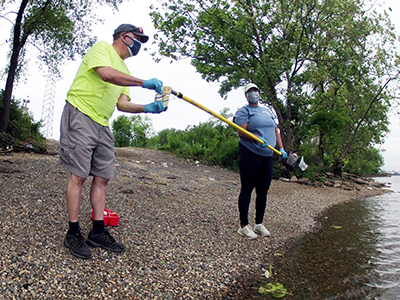 |
| DRBC staff collect a water sample to monitor bacteria levels. Photo by DRBC. |
DRBC's shore-based bacteria monitoring program will continue in 2021. From May - September, samples will be collected once weekly at nine locations in the Delaware River Estuary around Philadelphia and Camden.
This bacteria monitoring will be in addition to samples collected as part of the Delaware Estuary Water Quality Monitoring Program (aka the boat run), which runs once monthly.
In July and August, water samples will also be collected by boat in 5 transects near Chester, Red Bank, Penn's Landing, Pyne Poynt Park and Frankford Arsenal, with 5 samples along each transect. A total of four sampling events is planned.
Samples will be analyzed for E. Coli, Fecal Coliform and Enterococcus.
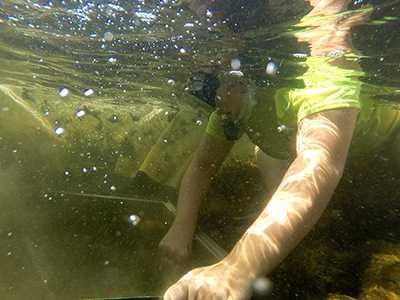 |
| DRBC staff head underwater to collect a sample of macroinvertebrates. Photo by DRBC. |
DRBC will perform biological monitoring in the non-tidal Delaware River, which is protected by DRBC's Special Protection Waters regulations.
Twenty-five sites will be monitored on the mainstem Delaware River once during August or September.
In addition to water chemistry data collected at each site, sampling will include macroinvertebrates, periphyton and habitat analyses.
DRBC staff will also develop and initiate a long term, basin-wide tributary macroinvertebrate monitoring program. The goal is for DRBC to have a uniform collection protocol for macroinvertebrates, allowing staff to monitor trends in the macroinvertebrate community composition on a basin-wide scale. Data are planned to be collected once during August or September.
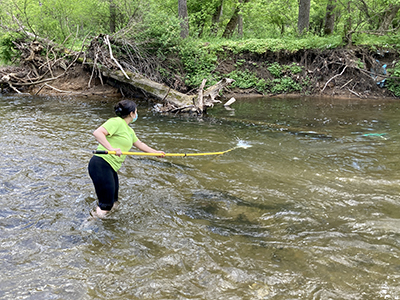 |
| DRBC staff collects a water sample to monitor for chlorides from the Pohatcong Creek, a N.J. Delaware River tributary. Photo by DRBC. |
This project will be collecting chlorides data over a two-year period at 27 mainstem & tributary sites in the non-tidal Delaware River Basin, which is known as DRBC's Special Protection Waters.
In addition to continuous data monitoring, grab samples are collected at each site once monthly throughout the study.
The purpose of DRBC's Special Protection Waters regulations is to prevent the degradation of its exceptional water quality. There is evidence of increasing chlorides concentrations in these waters, and while levels are still relatively low, additional monitoring is needed to ensure water quality protection and to identify any areas of special concern.
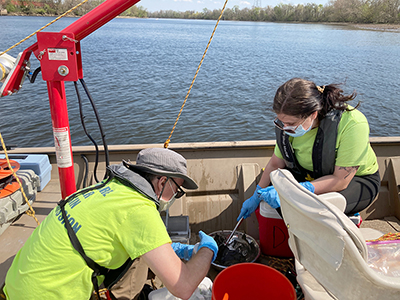 |
| DRBC staff collects a sediment sample from the Delaware River Estuary to monitor for PFAS. Photo by DRBC. |
DRBC staff will collect samples of surface water, sediment and fish to monitor for 40 different analytes of PFAS, a contaminant of emerging concern.
Samples will be collected in the spring and fall.
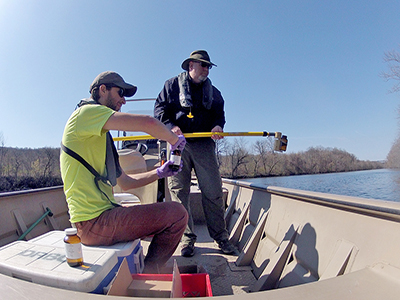 |
| Staff collect a water sample to monitor for 1,4-Dioxane, a contaminant of emerging concern. Photo by DRBC. |
Staff will be collecting water samples from the Lehigh River and Delaware Estuary tributaries to monitor for 1,4-Dioxane, a contaminant of emerging concern.
A total of three rounds of sampling in the Lehigh River and up to three rounds of sampling in Delaware Estuary tributaries are planned.
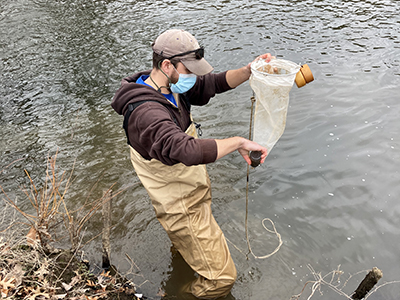 |
| DRBC staff collect a water sample from the Assunpink Creek to monitor for microplastics. Photo by DRBC. |
In 2018, DRBC received a grant to study microplastics in the tidal Delaware River and several tidal tributaries.
The final round of sampling occurred in early 2021.
In the summer or fall, two cleanup efforts will be planned, based on monitoring results; areas with heavy loadings of microplastics will be targeted.
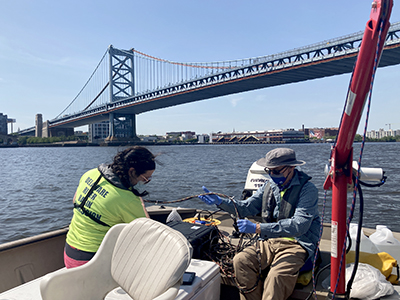 |
| DRBC staff collect water samples by the Ben Franklin Bridge to monitor dissolved oxygen levels. Photo by DRBC. |
To better understand how dissolved oxygen levels vary at different depths in the river, DRBC staff will be collecting dissolved oxygen profiles along transects at the Ben Franklin Bridge, Philadelphia, Pa. and near Chester, Pa.
These data will be collected during May, July and August.
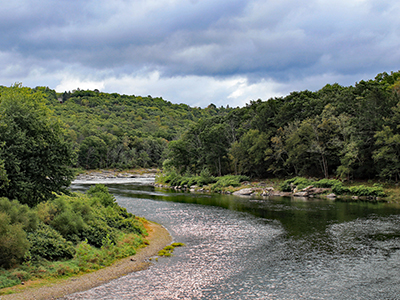 |
| The upper Delaware River near Skinner's Falls. Photo by Martha Tully. |
Using a hemispherical camera and special software, DRBC staff will identify reaches in the Upper Delaware and East and West Branch with insufficient tree canopy to provide shading.
Once identified, these reaches could be targeted for tree-planting using other funding sources, for example, grants.
Fifty miles of stream reaches in the upper Delaware River Basin are planned for assessment during a one-time, multi-day event in the summer.
Copyright © Delaware River Basin Commission,
P.O. Box 7360, West Trenton, NJ 08628-0360
Phone (609)883-9500; Fax (609)883-9522
Thanks to NJ for hosting the DRBC website